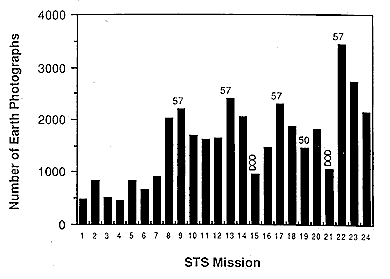

A useful summary of the SSEOP by Helfert and Wood, emphasizing photo scheduling, equipment, crew training, and the enormous problem of cataloging and inventorying, appears in the March 1989 (Vol. 4, No. 1) special issue of Geocarta International *. The recent (1996) publication * by astronauts Jay Apt, Michael Helfert, and Justin Wilkinson presents a stunning collection of the SSEOP pictures, with technical data for each.
Before summarizing the hand-held photography, the Large Format Camera (LFC) should be mentioned. The LFC was by far the most capable camera ever flown on an American manned mission. Hard-mounted in the Shuttle payload bay, this 405 kg camera, with a 305 mm focal length and a 23 by 46 cm format (see Mollberg and Schardt, 1988 *) was the central element of photo experiments on the few missions in which it was used. (It is probably the only space payload in which cast iron was a major constituent.) From a typical altitude of 300 km (200 miles), a frame covers ground dimensions of about 225 x 450 km (140 by 280 miles) . Although quite successful, the LFC has been retired for the time being, primarily because it requires dedicated payload bay space, attitude control fuel, and scheduled time, in contrast to the hand-held photography. This view of the Himalayas, near Mt. Everest, taken by the LFC during the 41-G mission in 1984, is typical of the quality achieved by this instrument:

Much the same area was photographed (looking west) during STS-17 in which the oblique view extends from the Ganges Plains in India, across the Siwalik Hills into the great peaks of Nepal and beyond onto the vast Tibetan Plateau, the highest broad land mass in the world which is snow-deprived over much of the year owing to precipitation fall out to the south as monsoonal winds blow northward.
In addition to the photography being more advanced and varied than during pre-Shuttle missions, the flights themselves are more frequent, longer, and cover more territory because of the higher orbital inclinations (up to 57°). Other major improvements:
1. Pre-flight Preparation: Shuttle crews are given extensive training in photography and in subjects such as geology, meteorology, oceanography, and ecology. Considerable stress is put on global change, especially since there are now three decades of space photography covering some areas. Extensive lists of observation sites are prepared for each mission, embracing so far a total of more than 1800 significant areas.
2. Equipment: Space cameras have been improved over the years, although the Hasselblad 70mm is still the "workhorse". With the wider variety of cameras and lenses, the crews can now match optimal equipment with the subject.
Ektachrome 64, which can be processed at the Johnson Space Center, is still commonly used, permitting valid comparison of Shuttle with pre-Shuttle pictures of similar subjects. An Electronic Still Camera has been successfully utilized on recent flights.
3. Post-mission Processing and Archiving: The SSEOP has carried out a systematic cataloging of Shuttle photographs. Early Shuttle mission photos were listed in printed catalogs but this practice has ceased in favor of Internet retrieval that favors easy selection of scenes and rapid downloading. Addition of digital data extracted from exposed film aids in this process. This allows for much better reproduction of colors and detail than with the multi-generation transparencies needed to preserve the flight film.
Code 935, Goddard Space Flight Center, NASA
Written by: Nicholas M. Short, Sr. email: nmshort@epix.net
and
Jon Robinson email: Jon.W.Robinson.1@gsfc.nasa.gov
Webmaster: Bill Dickinson Jr. email: rstwebmaster@gsti.com
Web Production: Christiane Robinson, Terri Ho and Nannette Fekete
Updated: 1999.03.15.